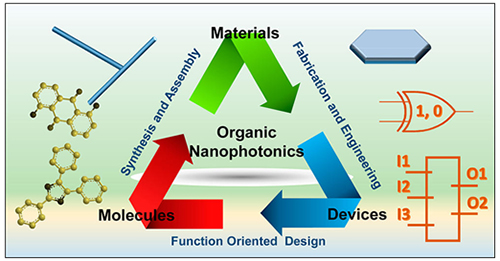In comparison with electronic devices, optical devices have advantages of high speed, broad bandwidth, and low driving power, which are crucial for the realization of nanophotonic circuits for next-generation optical information processing.
In recent years, Prof. Zhao Yong Sheng’s group in the Key Laboratory of Photochemistry in the Institute of Chemistry, the Chinese Academy of Sciences (ICCAS) have investigated the fabrication of photonic devices based on low-dimensional organic nanomaterials (Acc. Chem. Res., 2010, 43, 409-418, Angew. Chem. Int. Ed., 2013, 52, 8713-8717). They have developed various nanophotonic elements for integrated photonic circuits such as nanolasers (J. Am. Chem. Soc., 2011, 133, 7276-7279), sub-wavelength optical waveguides (Adv. Mater. 2011, 23, 1380-1384), photonic routers (J. Am. Chem. Soc., 2012, 134, 2880-2883), photodectors and optical sensors (Adv. Mater. 2012, 24, 2332-2336; Adv. Mater., 2012, 24, OP194-OP199), photonic logic gates and multiplexers (Adv. Mater., 2012, 24, 5681-5686; Adv. Mater., 2013, 25, 2784-2788), photonic transistor (Adv. Mater., 2013, 25, 2854-2859) and so on. These works demonstrated the great potential of the low-dimensional organic materials in the field of nanophotonics and paved the way for the fabrication of complex functional photonic devices.
The optical properties of organic microsystems are strongly dependent on their topological structures, manifesting a strategy to acquire desired photonic components via rational structural design. Recently, under the supports of the National Nature Science Foundation of China, the Chinese Ministry of Science and Technology, the Chinese Academy of Sciences, and Institute of Chemistry, researchers made a series of achievements in the controlled assembly of the desired optical components. Firstly, by summarizing their early works, they proposed a roadmap from molecules to the devices to power the following development of organic nanophotonic devices (Fig 1) (Chem. Soc. Rev., 2014, 43, 4325-4340,Acc. Chem. Res., 2014, 47, 3448−3458).
Recently, by utilizing the flexibility, processability, and compatibility of organic materials, they proposed a controlled emulsion assembly strategy to integrate the high quality whispering gallery mode (WGM) resonators with the 1D optical waveguides to realize the efficient output coupling of the WGM lasers (Fig 2) (J. Am. Chem. Soc., 2015, 137, 62-65). These results offer a comprehensive understanding of the assembly mechanism of organic composite materials and greatly improve the development of flexible photonics.
J. Am. Chem. Soc., 2015, 137, 62-65

Figure 1 Roadmap for Organic Nanophotonics

Figure 2 WGM laser based on self-assembled organic microdisks